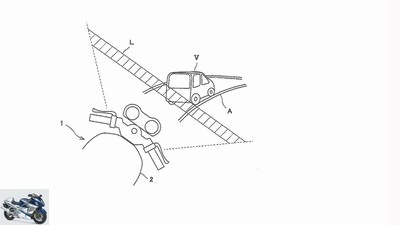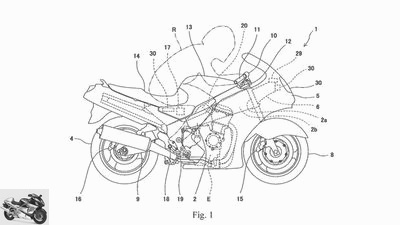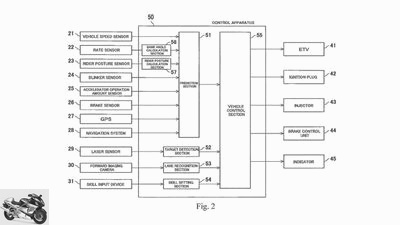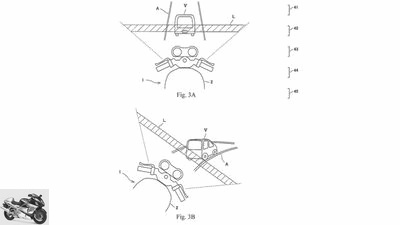Table of contents
- Kawasaki patent for curve detection Proactive instead of reactive
- Camera, laser sensors, sat nav and load sensors
- Posture sensors and turn signal sensors

Kawasaki
counselor
technology & future
Kawasaki patent for curve detection: proactive instead of reactive
Kawasaki patent for curve detection
Proactive instead of reactive
A new patent application from Kawasaki indicates that the motorcycle of the future could optimally adapt to the conditions before the curve.
Dina Dervisevic
06/25/2020
Cornering ABS, lean angle-dependent traction control, wheelie control – a lot has happened in the past few years when it comes to assistance systems for motorcyclists. Kawasaki’s patent drawings show that the Japanese are still thinking a few steps further in order not only to be able to use the existing systems reactively, but also to be able to use them proactively. This means that the motorcycle should ideally not only intervene to help when the tire is already slipping in the curve, for example, but rather adjust its setup optimally beforehand so that a driving situation does not arise in which the system would have to intervene. That’s the idea.
Camera, laser sensors, sat nav and load sensors
There are several options to choose from for the implementation. The most important new elements for this are a camera, laser sensors, a built-in satellite navigation system and a number of load sensors in the seat and in the footrests. The new facilities could work with existing sensors that provide information on throttle position, speed, lean angle and braking force. The data would then be fed to an on-board computer, which could provide the right setup for the next driving situation, the next bend.

Kawasaki
Countless data from various locations and sensors are recorded.
The camera and laser sensor are located behind a transparent element on the front part of the bike, the nose. The laser measures the distance to vehicles in front, while the camera is connected to an image recognition system to monitor lane markings and recognize the next bends. This information is compared with the maps on the navigation system in order to find out what the next corner will be like, how it will run, how tight it is – even before the driver brakes the corner.
Posture sensors and turn signal sensors
Sensors in the seat and in the footrests form a unit, which is referred to in the patent description as “rider posture sensor” is described, so in German “Posture sensors for the driver”. The data from these sensors should also help to identify which driving situation is imminent. If the driver shifts his body weight before cornering, this movement is a further indication for the on-board computer of what will happen next. If the driver activates the turn signal, the system also takes note of this. The prerequisite in this case is of course that we shift our body weight before a curve and that we blink before turning.

Kawasaki
Kawasaki would like to supplement existing ABS and traction control systems with load, indicator and position sensors in such a way that driving situations can be recognized in advance.
The collected data from all possible sensors and measuring instruments are first processed at different points in order to be compared centrally by the on-board computer. He then decides which adjustments are to be made and passes this on to the throttle valve, ignition, injection, ABS, etc..
Modes for driving skill
The calculations also take into account which driving skills the pilot has stored in the on-board computer: beginner, intermediate or advanced.

Kawasaki
Camera and laser sensors take care of image recognition and distance measurement and thus feed the on-board computer.
For one or the other, it all sounds like running away or driving away. The developers hope, however, that the driver will not notice anything. In the best case scenario, his motorcycle is simply always in the correct mode – with ABS and traction control systems that regulate so subtly that they are barely noticed.
Related articles
-
Patent for tricycle with tilting technology from Kawasaki
Kawasaki 4th pictures Kawasaki 1/4 Kawasaki has a patent for tilting technology with three wheels. The big difference to the previous techniques from…
-
Patent: Harley wants to adaptively drive in a convoy
Harley-Davidson 4th pictures Harley-Davidson 1/4 Using GPS tracking, motorcycles with adaptive cruise control should receive more precise speed…
-
Kawasaki patent: semi-automatic and hybrid motorcycle
Kawasaki counselor technology & future Kawasaki patent: semi-automatic and hybrid motorcycle Kawasaki with semi-automatic for hybrid Patent shows…
-
Kawasaki adapts Bimota technology: patent for stub axle steering
Kawasaki 6th pictures Kawasaki 1/6 Kawasaki has patented a steering knuckle system. Kawasaki 2/6 The Kawasaki system relies on a single-sided swing arm…
-
New Bosch motorcycle safety systems
Bosch 17th pictures Bosch 1/17 To make motorcycling even safer, Bosch is developing numerous new assistance systems. Bosch 2/17 Motorcycles should learn…
-
BMW patent: anticipatory chassis
Security campaign Consideration has right of way BMW counselor technology & future BMW patent: anticipatory chassis BMW patent for predictive chassis…
-
Second hand advice Kawasaki ZX-12R
Violinist counselor Used purchase Second hand advice Kawasaki ZX-12R Second hand advice Kawasaki ZX-12R KAWA-AIR Please bring your seats into an upright…
-
Honda patent: driver thinks, machine steers
Honda 9 pictures Honda 1/9 Honda has filed a patent in the US under number 20200371515 for controlling motorcycles by mind. Honda 2/9 The driver thinks…
-
Comparison test: Honda Hornet, Kawasaki Z 750, Suzuki GSR 600
Jahn motorcycles Comparison test: Honda Hornet, Kawasaki Z 750, Suzuki GSR 600 Comparison test: Honda Hornet, Kawasaki Z 750, Suzuki GSR 600 ABS shooters…
-
BMW Motorrad patent for gesture control
BWM counselor technology & future BMW Motorrad patent for gesture control BMW Motorrad patent for gesture control Guide with your fingers The functions…